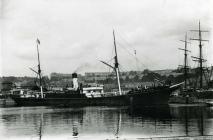Content can be downloaded for non-commercial purposes, such as for personal use or in educational resources.
For commercial purposes please contact the copyright holder directly.
Read more about the The Creative Archive Licence.
Description
The service life of the elegant deep-ocean voyager came to an abrupt end on 28 June 1915 when it was torpedoed without warning by a German U-Boat. The barque had been bringing a much-needed cargo of wheat to the UK from America.
The barque had been launched by Russell & Company, Port Glasgow, in December 1889. It was handed over to the 'Shire Line' of Thomas Law & Co of Glasgow in January 1890. Captain W C McGibbon was given first command.
The firm of Thomas Law & Co. were owners of a fleet of some thirty vessels, each fitted with every requisite for the comfort of passengers. When the DUMFRIESSHIRE entered service, the most important part of the firm’s business was the regular monthly service from Glasgow direct to Brisbane, Queensland, also Freemantle in Western Australia, and to other parts of the colonies. The firm were agents in Glasgow for the Queensland Government. As a consequence, much of the reporting of ship's service life appears in Australian newspapers.
The ship's first voyage, in March 1890, was from Antwerp to San Francisco and took 158 days. The ship then returned from San Francisco to Hull in 159 days.
The DUMFRIESSHIRE is noted as coming into Barry Docks on 18 July 1892 from Hull, in ballast, and setting out on 16 August for Algoa Bay, south African east coast, laden with coal (Barry Dock News, 22 July and 19 August 1892). Arrival down under in New South Wales is covered in more detail in the Newcastle Morning Herald and Miner's Advocate - 'Yesterday afternoon the fine four-masted ship Dumfriesshire reached this harbour from Algoa Bay. She was off the port on Saturday afternoon, but stood off the land, which she made again yesterday to the south of Nobbys. When being towed into the harbour the tugs BUNGAREE and GAMECOCK had all they could do to keep her from being driven ashore by the strong winds and currents. The vessel being light in ballast responded to the action of the current and wind too freely, but she was towed in in safety. Captain M'Gibbon is in command, and comes to the consignment of Mr R B Wallace, under charter to land a cargo of Greta coal for San Francisco. She left Algoa Bay on the lst ultimo, and had a good run to port.'
The ship was reported overdue on its voyage to San Francisco in early June 1893. But a reassuring report from San Francisco was printed 21 June in the Newcastle Morning Herald. Apparently, the ship had stopped at Pitcairn Island. The captain reported everyone well - "Since I was last in San Francisco,' said the skipper, "I have been in India, China, England, Africa, South America, and Australia. I have stopped at all kinds of little out-of-the-way places, but the only one that I ever hear "Ta-ra-ra-boom-de-ay" either whistled or sung at was Pitcairn. While we lay there the sailors taught the children, and before we sailed you could hear the men, women, and children at it morning, noon, and night."
The vessel was caught up in the New South Wales coal strike of 1896. It hosted meetings for the many sea captains who had arrived to load coal at Newcastle, but instead found themselves drawn into the bitter dispute between the miners and mine owners (July 1896).
In August 1896, a much happier event was reported - ships in the harbour had been decorated to celebrate the wedding of Captain M'Gibbon to Miss Grace Paton. The couple honeymooned on the ship's next voyage to San Francisco.
In December 1899, a fairly typical voyage was disturbed by a crew tragedy, as described in The Argus (Melbourne) - 'The four-masted barque Dumfriesshire, 2481 tons, arrived in the bay yesterday afternoon, from New York. Captain W. M'Gibbon, in charge of the vessel, reported that she left port on September 12, and crossed the equator on October 23, in long 25deg W, having had light variable winds to the NE trades, which also proved light. The meridian of the Cape was crossed in lat. 39deg s on November 23. She sighted the Island of St.Paul's on December 9, passing Cape Leuwin on December 18, and was off Cape Otway on the27th, at 5 p.m. The winds in running down the easting were unsteady and light at times, while between Capes Leuwin and Otway they were moderate from the north-west and west, with the barometer rising and falling rapidly. On November 16, the chief officer, Mr. Thomas T. Wilkie, died of peritonitis and was buried at sea. The deceased, who was about 40 years of age, was a native of Kirkcaldy, Scotland, and married. The Dumfriesshire is one of the finest sailing vessels that has entered the port. She was built 10 years ago at Port Glasgow, for T Law, Glasgow, The accommodation for the crew is very fine, consisting of large house admidships, filling the deck from side to side, and she is fitted with the latest labour-saving appliances….'
Although much of the ship's early life appears to have been in the coal trade, it also carried general cargoes, nitrate, and, for its time, one of the largest consignments of timber from Portland, Oregon, to Melbourne (August 1904). Also a record wheat cargo (34,318 bags) from Melbourne to Callac in April 1906.
After 25 years circumnavigating the globe, the ship's service life came to an end on 28 June 1915. It was then under the command of Captain R. W. Furneaux. The DUMFRIESSHIRE had left San Francisco on the 22 January for Falmouth to await orders for the cargo of wheat/barley it was carrying. These orders sent the ship north to Dublin. It was to offload and then go to New York for its next cargo to Australia.
When the torpedo exploded, survivors' described how the deck was blown into the air. The lifeboats had already been swung out and so the crew, including three Swedes and an American, were able to make their escape before the vessel sank. The periscope of a German submarine was seen by the patrol boats which rushed to the scene, some 25 miles southwest of the Smalls.
Once again, Milford Haven would welcome the survivors of a German u-boat attack. This time, it would be the steam trawler WEYMOUTH which brought them safety.
What happened to the survivors of the DUMFRIESSHIRE in Milford Haven? Or later? Did they take to the sea again, despite the threat of German uboats? We would love to know....
The u-boat was U-24, under the command of Kptlt Rudolf Schneider. The submarine undertook 7 wartime patrols and sank 34 ships and HMS FORMIDABLE on 1 January 1915 off Lyme Regis. It damaged 3 other vessels and took another as a prize. The submarine was surrendered on 22 November 1918 and broken up at Swansea in 1922.
Follow these links to read more about the everyday life on board the DUMFRIESSHIRE down under:
The Advertiser (Adelaide, South Austraila), Wednesday 18 April 1906, pg7, http://trove.nla.gov.au/ndp/del/article/5070339
The Argus (Melbourne), Friday 29 December 1899, pg4, http://trove.nla.gov.au/ndp/del/article/9043420
Newcastle Morning Herald and Miners' Advocate (NSW), Thursday 6 August 1896, http://trove.nla.gov.au/ndp/del/article/136261187
Newcastle Morning Herald and Miners' Advocate (NSW), Friday 245 August 1905, http://trove.nla.gov.au/ndp/del/article/138380701
The Sydney Morning Herald, Thursday 9 July 1896, http://trove.nla.gov.au/ndp/del/article/14057583
What other short articles can you find in National Library of Australia's online newspaper resource?
https://trove.nla.gov.au/newspaper
Or in Welsh Newspapers Online?
http://welshnewspapers.llgc.org.uk/en/home






Do you have information to add to this item? Please leave a comment
Comments (0)
You must be logged in to leave a comment